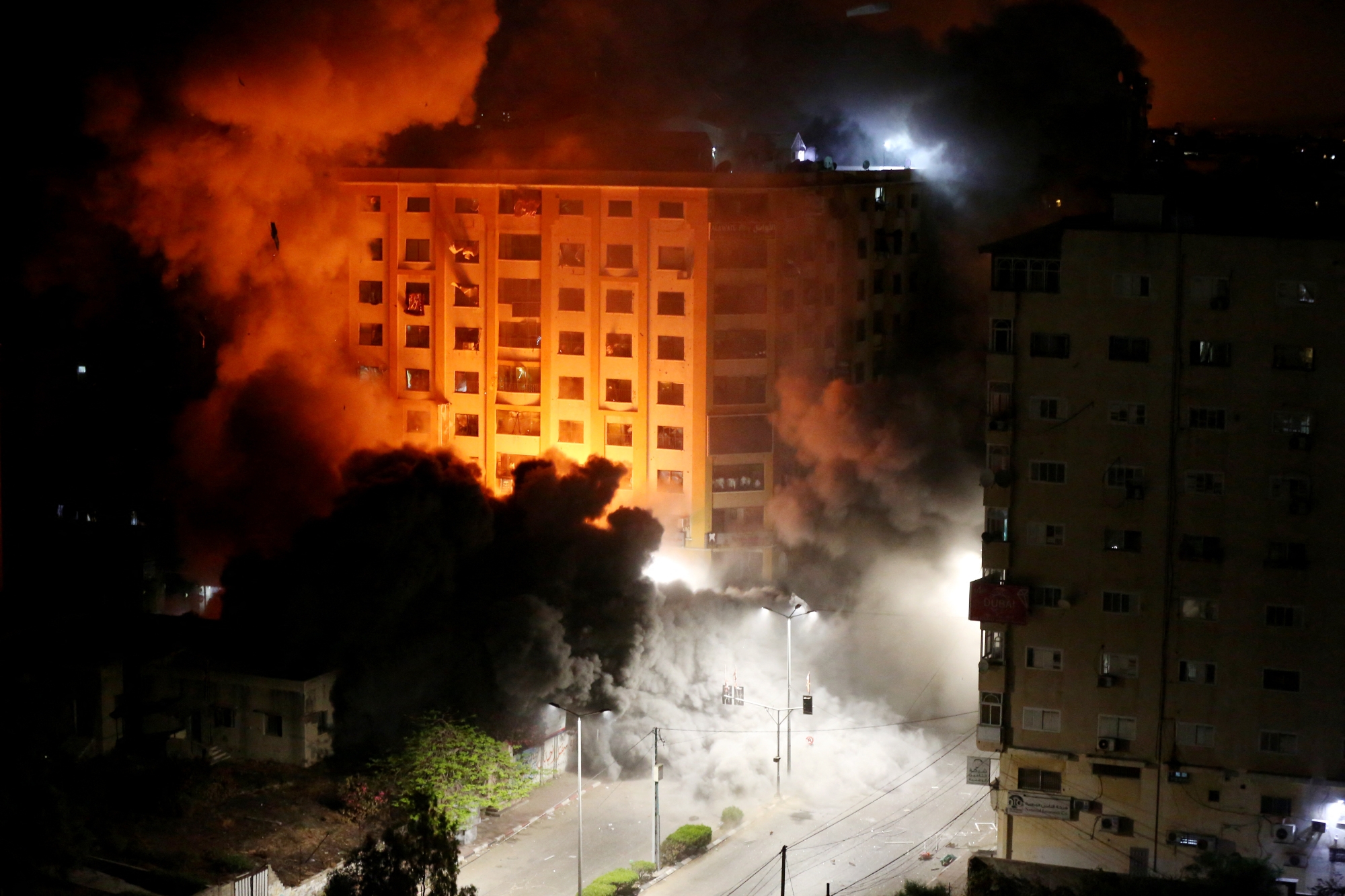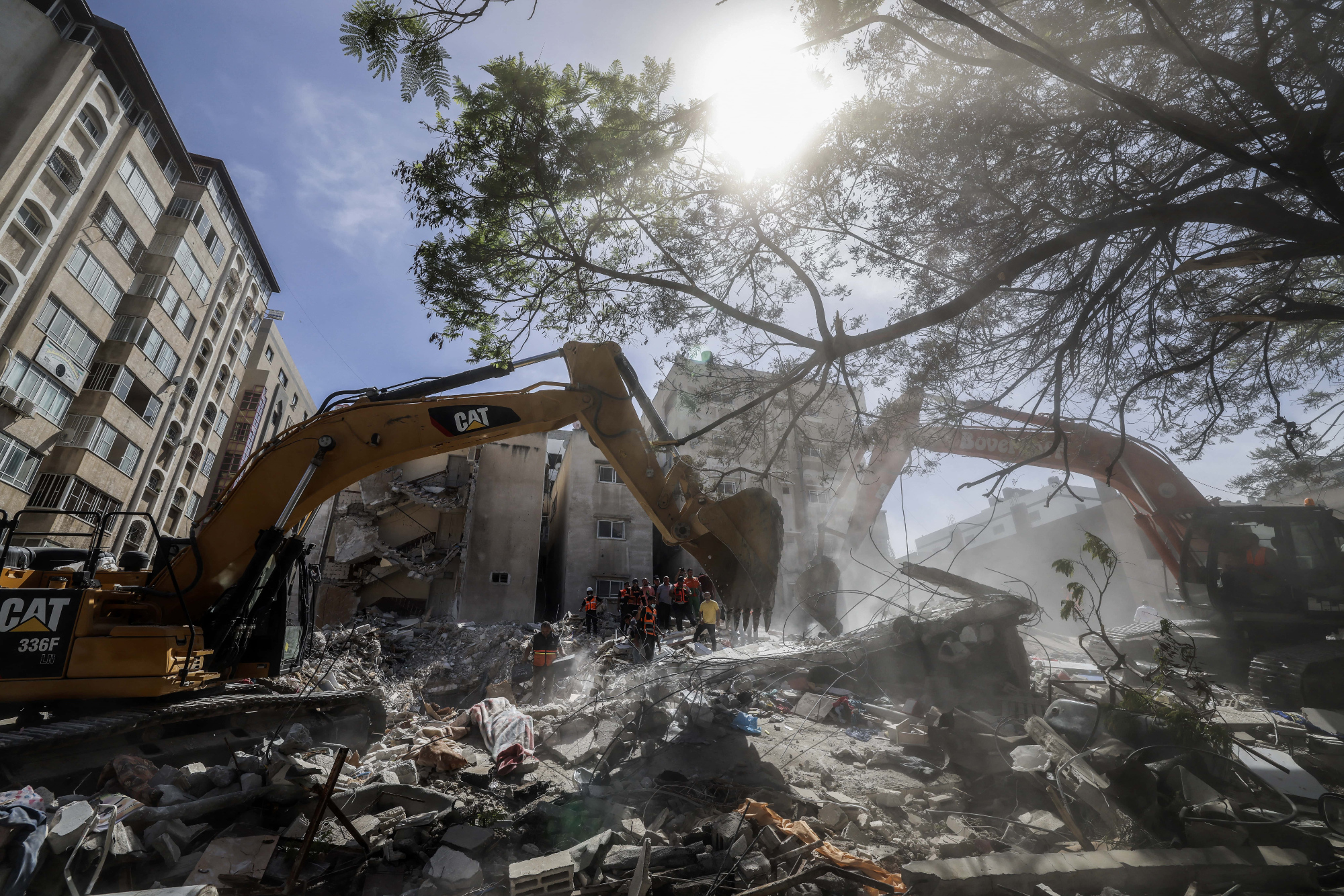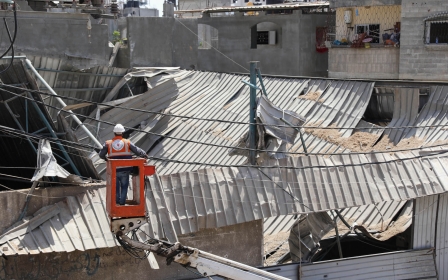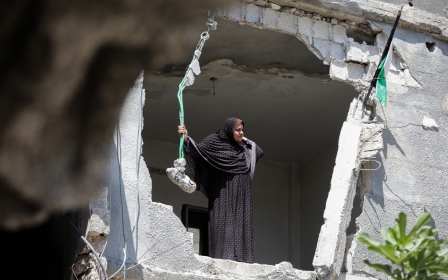Faulty, indiscriminate, lethal: Israel opts for Vietnam-era bombs in Gaza

As general purpose bombs go, few are more destructive than the Mark-84, a roughly 907kg weapon first used by the US during the Vietnam War.
Containing more than 400kg of explosive, the four and a half metre steel-cased bombs have a “kill radius” of more than 30 metres and create a supersonic wave of pressure when they explode.
They can destroy nearby buildings and “rupture lungs, burst sinus cavities and tear off limbs” from anyone within 350 to 360 metres of the blast, according to the UN.
The Mark-84, or MK-84 - a “bunker-buster” designed to penetrate layers of steel or concrete - is therefore considered particularly dangerous when dropped in civilian areas.
New MEE newsletter: Jerusalem Dispatch
Sign up to get the latest insights and analysis on Israel-Palestine, alongside Turkey Unpacked and other MEE newsletters
The bomb is so lethal when dropped in highly populated areas that the independent UN commission which investigated the 2014 war in Gaza cautioned specifically against its use, warning that it would likely "constitute a violation of the prohibition of indiscriminate attacks".
Yet six years later, bomb disposal experts in Gaza tell Middle East Eye (MEE) that of the 2,750 aerial attacks on the Gaza Strip during an offensive this May, which killed 248 Palestinians, including 66 children, it was the MK-84 that Israel dropped the most during the 11-day onslaught.
The Gaza interior ministry's Explosive Ordnance Disposal (EOD) team combs the besieged enclave after each Israeli bombardment, clearing the unexploded ordnance littering the strip. The remnants they have found most frequently since May, they say, are from MK-84s.
It was MK-84s, for example, that killed at least 42 people - including five members of the same family - during the bombing of al-Wehda street, in al-Rimal, to Gaza’s north, on the night of 15 May, according to the EOD.
The MK-84's use in May is particularly baffling given that the Israeli Air Force has another, more modern bomb in its arsenal designed to do the same job with far less risk to civilians.
Israel may have been guilty of war crimes for attacks that killed Gazan civilians, according to Human Rights Watch. (Hamas, which fired untargeted rockets into Israel, killing 13, may also have committed war crimes.)
MEE asked the IDF why it used the bomb and whether it dropped any of the more targeted weapons in its arsenal. The IDF had not answered MEE's questions by the time of publication.
A wayward weapon
As well as being mortally dangerous to civilians, MK-84s are also often inaccurate and faulty.
The bombs can land up to seven metres away from their target, according to the UN.
And in a 2016 interview, Dani Peretz, the Vice President of Engineering at Israeli Military Industries - now part of Israeli weapons manufacturer Elbit Systems - said that MK-84s used in the 2006 Lebanon war failed to explode 40 percent of the time. This figure is usually around 5 percent, according to Action On Armed Violence (AOAV), a London-based arms monitor.
Unlike when they were first produced in 1955, MK-84s are now often fitted with a Joint Direct Attack Munition (JDAM), a US-developed kit that guides “dumb bombs” with GPS. These "smarter" versions of the weapon are known as GBU-31s.
But the JDAM, Peretz found, “changes the bomb's behaviour”.
It meant that in some cases “the [MK-84] reached the target but… hit the wrong room,” and in others, "the fuse was detached from the bomb and it failed to explode".
Unexploded bombs can suddenly detonate when moved, killing or maiming people. Many Gazans remain displaced or out of school because MK-84s have burrowed into the earth beneath their homes without exploding.
Four such deep-buried bombs currently lie under schools run by the United Nations Relief and Works Agency for Palestine Refugees in the Near East (UNRWA), according to the EOD, meaning they remain closed. An UNRWA spokesperson didn't reply to requests to comment.
Other less common bombs the EOD found during and after the offensive were US-made GBU-39s, or Small Diameter Bombs, which are far smaller than the GBU-31 and potentially less harmful to civilians; and US-made BLU-109s, bunker-busters that are packed with less explosive than the GBU-31 but are “likely to inflict a very similar level of blast damage”, according to AOAV.
Kill area
The Israeli Air Force has another bomb in its arsenal that does the same job as the MK-84 while posing far less risk to civilians.
A brochure for a bomb called the MPR-500, manufactured by Elbit Systems, boasts that it “delivers the effective performance of the powerful MK-84” without the “high collateral damage”, saying that the MPR-500 has a lower “kill area”.
'Precision and accuracy are somewhat irrelevant when you are dropping bombs with a 360-metre blast radius on one of the most densely-populated areas in the world'
- Murray Jones, researcher at Action On Armed Violence
The MPR-500, like the MK-84, is designed to penetrate buildings, rooms or tunnels, before exploding. Its manufacturer has said it is between 90-95 percent likely to hit its target and detonate properly, compared to 60 percent for the MK-84.
In fact, the manufacturers said they started developing the MPR-500 precisely because of the unpredictability - and expense - of the Mark-84.
Elbit Systems may well be exaggerating the gulf between the danger and effectiveness of each bomb.
Their brochures use several “apples-to-orange” comparisons, Mark Hiznay, associate director of the arms division of Human Rights Watch, told MEE.
And the claims of low collateral damage may also be questionable, given MPR-500s killed 28 civilians in 2014, including 15 children, according to the UN Independent Commission of Inquiry report on the 2014 Gaza Conflict.
But Elbit convinced the US Air Force the weapons were worth investing in.
The Israelis, too. An Israeli armed forces spokesperson confirmed to MEE that MPR-500 bombs are “in operational use in the IDF”.
However, Gaza’s EOD team told MEE that while they saw traces of MPR-500s on the ground in 2012 and 2014, they had seen no evidence of the bombs being used in May.
The IDF gave no comment when asked about whether they had dropped MPR-500s on Gaza in May and experts say the exact number of MPR-500s in Israel’s arsenal is likely highly classified.
A spokesperson for Elbit, which has factories in various countries, including the UK, didn't answer questions about how many MPR-500s the company has sold to Israel. Elbit has repeatedly hinted that all its systems are used by the IDF, without giving details.
Why, then, might the Israelis be using MK-84s instead of MPR-500s if they are known to be highly destructive, wayward and more harmful to civilians?
Why use MK-84s?
1) Getting rid of old stock
Generally, air forces are known to use old stockpiles, says Brian Castner, a senior crisis adviser at Amnesty International, who specialises in weapons and military operations.
Bombs are expensive to store and maintain and need to be kept under heavy guard. They have a shelf life and, after a point, it can become dangerous to handle and load them, so it makes sense to drop the oldest first.
What’s more, if Elbit Systems - which has hired multiple former high-ranking IDF officers and wields influence over the IDF - wants Israel to stock up on MPR-500s, then it would be in its commercial interest to pressure the IDF to get rid of its MK-84s as fast as possible.
Neither the IDF nor Elbit answered MEE's questions about this.
2) US pressure
Under a security assistance agreement spanning 2019-2028, the US has agreed - subject to congressional approval - to give Israel $3.8bn annually in foreign military financing, almost all of which it has to spend on US-made weapons.
What Israel buys is mostly decided by the Pentagon, and the Pentagon also wants to get rid of old bombs. So the US may be looking to offload some of its MK-84s, which it has sold to Israel in the past.
A US Department of Defense spokesperson didn't reply to a request for comment.
3) Financial concerns
Every year, the Israeli defence ministry asks for a special extra budget to deal with unexpected threats.
And the more bombs the IDF drops, the more it needs to replenish its arsenal - and the more money it needs to do so.
In 2014, Netanyahu promised to cut the defence budget but reneged when the army demanded 10 billion Israeli shekels (more than $3bn) after its invasion of Gaza.
“We have to care for the standard of living, but first we have to care about life itself,” Netanyahu said of the decision, echoing fears stoked by the MOD that the IDF needed more investment to be ready for the next confrontation.
4) Operational necessity
On 14 May, the IDF misled foreign media that ground troops had entered Gaza, which some saw as a ploy to hit Hamas by driving their fighters into tunnels before striking them with more than 400 bombs.
As the so-called "Metro" is a vast network of tunnels, it’s not enough to breach it at a certain location. High-fragmentation bunker-busters, it could be argued, might have been likelier to kill and maim more underground fighters.
Regardless of the justifications, military or otherwise, the use of MK-84s in built-up civilian areas when the IDF has less harmful bombs in its arsenal that do the same job raises further questions under the laws of war about the proportionality - the potential loss of civilian life - of Israel's recent bombing campaign.
Who’s responsible?
The blame for this lies mostly with the Israelis, but the countries selling them bombs that kill civilians are also responsible. The US is by far the biggest seller of weapons to Israel, followed by Germany and Italy.
Of the bombs the EOD said were dropped on Gaza, the US has sold both GBU-39s (SDBs) and BLU-109s, as well as the JDAMs that go on the MK-84s, while Israeli company Elbit Systems makes the MPR-500s.
It has also sold Israel MK-84s, but other countries may have as well.
“It is weirdly difficult to say exactly which countries manufacture and sell Mark-80 series bombs [of which the MK-84 is the biggest],” said Castner of Amnesty.
US-based General Dynamics makes Mark-80 series bombs for the US military and, according to several Defense Department notifications to Congress, has also sold thousands to Israel.
In 2007, the US approved sales to Israel of 3,500 MK-84s, worth up to $65m, which were made by General Dynamics. The company was also involved in a larger deal worth $647m in 2012, which included 3,450 more MK-84s.
In 2015, the US approved a sale of 10,000 JDAM kits for MK-84s. Again, General Dynamics were named as a contractor.
But other NATO countries - including Spain, Italy, Poland, Norway, France, and Turkey - are licensed to sell them, too, as well as companies in Russia and China.
“Increasingly, Gulf countries are also being licensed to make components,” added Castner, “and it's also clear that some countries just take the measurements and try to make them themselves.”
For the Gazans caught in the bombing, though, the end result was the same whoever made and sold the bombs.
According to AOAV, 98 percent of the total 1,474 casualties in May were civilians - and three in four of these casualties were caused by air strikes.
“Airstrike targeting technology has improved over the past few decades, but precision and accuracy are somewhat irrelevant when you are dropping bombs with a 360-metre blast radius on one of the most densely populated areas in the world," said Murray Jones, an AOAV researcher.
"Using Mk-84 bombs in Gaza means large scale civilian harm is inevitable."
Maha Hussaini contributed to this report.
This article is available in French on Middle East Eye French edition.
Middle East Eye delivers independent and unrivalled coverage and analysis of the Middle East, North Africa and beyond. To learn more about republishing this content and the associated fees, please fill out this form. More about MEE can be found here.








